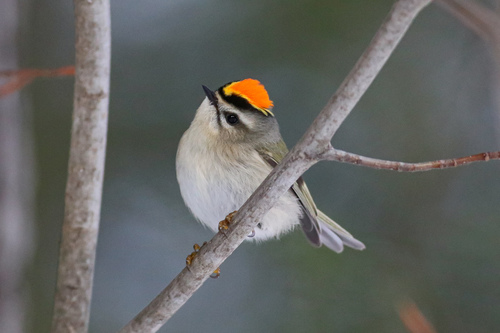
Golden-crowned Kinglet
The Golden-crowned Kinglet (Regulus satrapa) is a tiny, active songbird native to North America. Known for its vibrant golden crown stripe, bordered by black, this bird is a marvel of adaptation, thriving in coniferous forests even during harsh winters. Its ecological role is primarily as an insectivore, helping to control populations of forest insects. While not holding major cultural significance, it is a favorite among birdwatchers for its energetic behavior and striking appearance.
8-11 cm
Length
16-18 cm
Wingspan
Least Concern
Conservation Status
Distribution
The Golden-crowned Kinglet breeds across much of Canada, the northern United States, and higher elevations of the Appalachian and Rocky Mountains. During winter, they migrate southward, reaching as far as Mexico and the Gulf Coast. They are found in a variety of forested habitats.
Lifespan
Average lifespan in the wild is estimated to be around 2-5 years, though some individuals may live longer.
Golden-crowned Kinglet's Habitat
Habitat Types
Coniferous forests, Mixed woodlands, Spruce-fir forests
Climate Zones
Temperate, Boreal, Montane
Adaptations
These kinglets have specialized feathers that provide excellent insulation, allowing them to survive extremely cold temperatures. Their small size and agility enable them to forage effectively in dense foliage.
Variations
Several subspecies are recognized, differing slightly in plumage coloration and size, primarily based on geographic location (e.g., *R. s. satrapa* in the east, *R. s. olivaceus* in the west).
Appearance
Breeding Plumage
Plumage is generally similar year-round, though breeding males may have brighter crown patches.
Seasonal Feather Changes
Minimal seasonal variation.
Sex Based Plumage Differences
Males have a bright orange-yellow central crown stripe bordered by black, while females have a yellow crown stripe bordered by black.
Notable Features
Bright golden crown stripe, Black lateral crown stripes, White wingbars, Olive-green upperparts
Diet and Feeding
Primary Foods
Insects, Spiders, Insect eggs, Small arthropods
Foraging Behavior
Golden-crowned Kinglets are highly active foragers, constantly gleaning insects and spiders from foliage, often hanging upside down. They frequently hover and flit between branches.
Specializations
Their small, pointed bills are well-suited for picking tiny prey from crevices and needles.
Seasonal Diet Variations
During winter, when insects are less abundant, they may also consume some small seeds and berries, though insects remain the primary food source.
Behavior
Social Structure
Generally solitary or found in pairs during the breeding season. They may form small flocks during migration and winter.
Communication
High-pitched, thin calls ('see-see-see'), Complex songs during breeding season, Wing flicks and crown displays
Migration
Many populations are migratory, moving south for the winter. The timing and distance of migration vary depending on the breeding location and severity of the winter.
Territorial or Group Behaviors
Males defend territories during the breeding season through song and displays. Outside of breeding, they are less territorial and may join mixed-species foraging flocks.
Conservation
Threats
Habitat loss (particularly logging of mature coniferous forests), Climate change (potential shifts in habitat and prey availability), Collisions with buildings
Protection Programs
General forest conservation efforts, Monitoring programs (e.g., Breeding Bird Survey)
Local National Laws
Protected under the Migratory Bird Treaty Act in the United States and similar legislation in Canada.
Population Trend
Stable
Population Estimates
The global population is estimated to be around 110 million individuals.
Interesting Facts
They are one of the smallest songbirds in North America.
Their tiny size allows them to exploit food resources that larger birds might miss.
They can withstand extremely cold temperatures.
Their dense, insulating plumage and high metabolic rate help them survive sub-zero conditions.
They often raise two broods in a single breeding season.
This helps to offset their relatively short lifespan.
Faqs about Golden-crowned Kinglet
What do Golden-crowned Kinglets eat?
They primarily eat insects, spiders, and insect eggs, gleaned from foliage.
Where do Golden-crowned Kinglets nest?
They build cup-shaped nests high in coniferous trees, often suspended from branches.
Are Golden-crowned Kinglets migratory?
Many populations are migratory, moving south for the winter, although some may remain in their breeding range year-round if conditions permit.
How can I attract Golden-crowned Kinglets to my yard?
While they primarily inhabit coniferous forests, providing a variety of native trees and shrubs, especially conifers, can increase the chances of attracting them, especially during migration. A water source can also be beneficial.
Copyright @ Nature Style Limited. All Rights Reserved.
 English
English